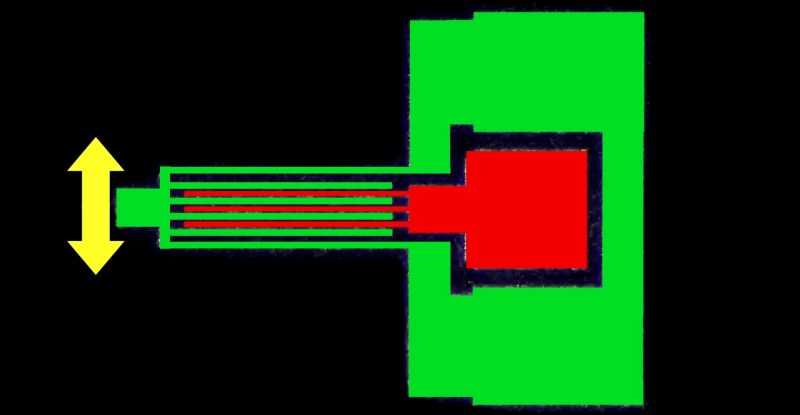An accelerometer is the ubiquitous little sensor that tells your tablet when to flip orientation or informs the brain of your quadcopter how closely its actual actions are matching your desired ones. In a quick three minutes, [Afroman] explains what is inside an accelerometer and how they work.
It turns out the tiny devices that report acceleration in one, two or three dimensions are not powered by magic complicated mechanisms but very simple Micro Electro-Mechanical Systems or “MEMS.” MEMS are similar to copper/silver/gold-wired integrated circuits except in a MEMS circuit conductive silicon is used and they actually physically move, but only just a bit.
The secret is in creating microscopic capacitors along a weighted lever that flexes in response to changes in velocity. When the plates flex the distance between them changes which alters the capacitance. This translates physical motion into voltage which can then be interpreted by the rest of your circuit. The chemistry behind MEMS is interesting too.
This Christmas when your laptop’s power cord clotheslines your cousin’s kid, your hard drive has a chance of parking the head (on the drive, not on the child) between fall and impact and preventing damage (to the drive, not to the child) because of an accelerometer. If bad roads cause you to drift into the ditch, it is an accelerometer that senses the crash and tells your airbag to deploy before your body hits the steering wheel.
The MEMS market is exploding right now and for us hackers in particular, Wearables are looking to be a big part of that growth.















There is no silber and gold in integrated circuits and relatively few have Copper. Wth?
Gold is often use for the interconnects between the silicon and the legs or other attachment points in an integrated circuit or silicon chip package.
Again not a good source but a lazy source, wikipedia: http://en.wikipedia.org/wiki/Integrated_circuit <— Look through the images on the right. Many outright mention the types of metal conductors used.
Gold is used for bumping silicon all the time, gold is used for wire bonding from silicon to package as well. The only other wire bong material I’ve seen is copper but was difficult to use.
Copper is used in a lot of silicon for redistribution or in some processes copper aluminum mix is used for actual regular metal interconnect.
Wow, that’s some impressive small scale mechanical engineering.
I dont think vehicles use accelerometers for airbag deployment (They might these days). Believe they have a different mechanical assembly entirely called an Inertial switch and is usually a one time deal not a sensor.
Correct me if im wrong…
“Correct me if im wrong…”
Well, ditto. My experience with MEMS is very rudimentary. I.E. It probably tripled while I was writing this article. You’re probably more knowledgeable.
I went looking for some numbers on the size of the MEMS market and some trends. I heard anything from $11-80 billion/year, and quantities rising (even though with advancements bringing costs down, not necessarily a larger worldwide market).
A lot of what I came across were projections for automotive sensors like those on airbags (projections actually showing these slowing, as vehicle sales haven’t been great). Umm, not a great source but the easiest source… http://en.wikipedia.org/wiki/Microelectromechanical_systems#Applications <– See the accelerometers for automotive part. Too lazy to dig into the MEMS journals and find articles, but, rough memory of stuff I skimmed seemed to corroborate that they are in airbags.
Accelerometers are totally used for airbags! Analog have been making high g accelerometers for that purpose for years.
e.g.
http://www.analog.com/en/mems-sensors/mems-inertial-sensors/adxl180/products/product.html
Welp must be a recent thing these past few years I guess but hard to say since they’re heavily protected and a pain in the ass to take apart to find out… All the ones I tore into gives you a nice pretty gold ball for your mutilation labors :D
I knew about MEMS accelerometers, but I had to look up how they made MEMS gyros also. The MEMS gyros are almost identical to the accelerometers, except they use an electric field to induce a vibration in the accelerometer. If the device is stationary, the deflection is the same in both directions. If the device is rotating, the deflection will be greater in one direction and less in the opposite. The magnitude of offset is proportional to the angular rotation rate: Voila! A solid state gyroscope – deceptively simple.
Not sure one can call MEMS solid-state, since they have parts that actually move ;-)
For a more pedantically solid-state gyro, I suppose there’s always the Ring Laser Gyro. Assuming the laser is solid-state, that is.
Oh wait, the article I’m reading about them now says that to avoid problems at low rotation rates, a spring oscillates the laser cavity. That’s pretty neat, but maybe it moves more than a MEMS gyro does in pure displacement terms? I’m not sure anymore.
MEMS devices are super cool!
The title made me cry a little bit though – while the devices are really “simple”, doing calculations on these little buggers is not easy. I still have nightmares from university of calculating characteristics and operating ranges of MEMS accelerometers and gyros. Blah!
They are super cool though! Super cool!